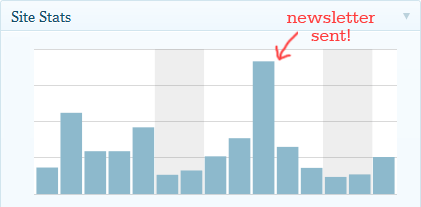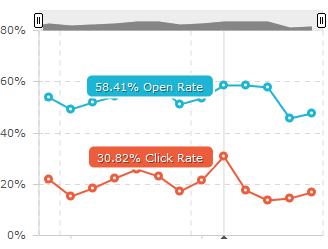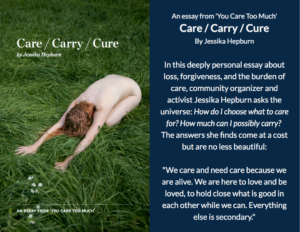

For a while, I struggled with my newsletter, and wasn’t quite sure what to do with it. I didn’t really understand what the difference was between email subscribers, Facebook fans, Twitter followers, and people reading my blog. What to do, what to do?
It turns out an email newsletter is a very valuable marketing tool, and I feel like I’ve gotten to a sweet spot with my newsletter, and would like to share a bit of what I’ve learned.
Why should I send newsletters?
Good question, and exactly what I had been unsure about! I already had people following my updates on Facebook and seeing what I was saying on Twitter. Now I needed another place where I was supposed to come up with engaging things to say? C’mon!
Your posts on Facebook and Twitter go by quickly, in a stream of other content. If your customer isn’t checking Twitter around the time you post, she’ll likely never see your tweet, and Facebook’s algorithm only shows your posts to some of your fans. There are also plenty of people who would be happy to get an email from you, but are unaware of you on social media.
Your email newsletter will go directly to your customer’s email box to be read when she gets around to it. This is extremely valuable! People place a high priority on their inbox, and if someone has asked you to send them newsletters, by all means, send them newsletters!
What should I use to send newsletters?
While it’s possible to just save addresses to your contact list and send emails to your subscribers from your email program, please don’t do it! There are many reasons to use mailing list software, and these are the reasons I find most important:
Mailing list software:
- Makes it simple for people to subscribe and unsubscribe
- Makes it easy for you to send emails
- Helps keep your email out of spam folders
- Helps your emails look good in different email programs
- Gives you reports so you can see what’s working well
At Aeolidia , we’re most familiar with MailChimp and can recommend it. It has an easy to use interface and lots of considerations for making sure your newsletters aren’t reported as spam. They have tons of great resources and articles, and they have a great sense of humor, as well! MailChimp is free or cheap if you have a small list or don’t send emails very frequently.
Who can I send to?
Ideally, the only people on your email list will be people that purposefully subscribed. However, there are grey areas, and MailChimp has a great article to help you decide if your list is okay or not: Is my list okay to use in MailChimp?
This example is probably pertinent for many of you:
I’ve been running an e-commerce site for years. Now I’m ready to start sending my customers email newsletters. They’re my customers, so I have a “prior business relationship” with them, right?
Maybe. Problem is, permission goes stale after about 6 months. So weed out the recipients that haven’t ordered (or heard) from you in a while. Send a “Thanks for being a customer. Would you like to subscribe to our newsletter?” You might even include an e-coupon as a gift for opting in. Use common sense. How would you like to suddenly start receiving full-blown email newsletters from some convenience store you bought milk from 5 years ago?
How often should I send email?
If you only send email rarely, in the months in between your emails, your subscribers may forget why they subscribed and who you are, and are much more likely to delete, unsubscribe, or report your mail as spam. If you send every day, there’s a greater chance that your subscribers are going to get tired of hearing from you. It seems that a good rule of thumb is to send once a week or once every two weeks.
Consistency is important. If you normally send once a month, then suddenly increase to twice a week, you’re going to unpleasantly surprise a lot of people. Choose a schedule, and stick to it. If you want to make a big change to schedule, why not mention it in a newsletter prior to making the change?
What kind of content should I send?
This is the big question! I would love to have some conversation about this in the comments. Deciding what to send in emails is going to depend on:
- Your business type and what you sell
- What your customers are interested in online
- What you’re trying to accomplish with your newsletter
- What you’re posting on other social media outlets
If you check out my End Each Day With an Empty Inbox article, you’ll see that I’m a ruthless unsubscriber from newsletters. I do have a few newsletters I keep up with, though, and here are some of the small biz ones, and why I continue to be interested in them:
- Noisette Academy’s Happy Start Up emails – Isa sends thoughtful emails that feel like a personal note from her to me, with a new and interesting twist on a problem all small businesses are likely to run into. I told her recently that I feel sorry for anyone not subscribed! You can’t find this content anywhere but in her emails, so it’s a no-brainer to subscribe.
- Hawthorne Threads’ newsletter – This follows the same format every time – photos of new fabrics in stock, and then a giveaway winner announced and a new giveaway to enter. I can see what’s new without going to their site, and there’s always a chance of winning their giveaway.
- MyFonts’ Rising Stars email – This shows me what fonts have been most popular recently, giving me a good overview of trends in graphic design and alerting me to fonts I may be interested in purchasing.
I also subscribe to mailing lists for service providers that I use, so I can take advantage of any coupons they may send. Your content needs to be interesting or useful (and preferably both!) to be successful.
You may want to send more than one type of content. This is okay to do! Mailing list programs make it very easy by allowing you to segment your mailing list into groups, and by letting your subscribers self-select the types of content they want to see. I have three different types of info that I send, and you can see how I explain and segment this on my signup form (as well as give people an idea of frequency): Aeolidia mailing list subscribe.
How can I tell if my content is successful?
To determine success, you need to first have a goal. My goal is to keep Aeolidia on the minds of potential clients, so that they will eventually contact me to purchase services. I attempt to do this by featuring interesting content from around the web that is relevant and useful, and by directing people to our blog. On our blog, small business owners get this same type of useful content, and they also can see proof of our expertise, view interesting work from our portfolio, and read glowing testimonials from our clients.

The best way to judge the success of your newsletter is to view your stats directly in the email tool, and compare to past campaigns. MailChimp has great reporting, letting me see and compare my open rate and click rate, as well as see exactly which links are being clicked. This way, it’s easy to see what content is interesting to people and what is a waste of space.
You can monitor your success by:
- Viewing your mailing list stats
- Seeing how many direct emails, inquiries, or sales you get
- Checking for noticeable increases in traffic on newsletter days
- Seeing if your content is shared by your subscribers
Let’s talk about newsletters
I put a lot of work into my newsletters, and feature articles that are useful to small creative businesses (you!). You can see one of my recent newsletters at this link: Aeolidia newsletter. If you like what I’ve put together, please subscribe!
If you have a mailing list that you think the Oh My! community would like, please post a link to a past newsletter or to your join form in the comments so we can check it out.
What newsletters do you subscribe to, and what do you like about them? Have you hit on a great method for sending newsletters? What do you struggle with when putting a newsletter together? I’d love to share some advice in the comments!


[…] Read article on Oh My Handmade » […]